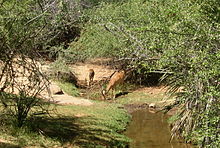Tsavo West National Park
|
Tsavo West National Park
|
|
|
The landscape of Tsavo West |
|
| location |
Taita-Taveta County , Kenya |
| surface | 9,065 km² |
| WDPA ID | 19564 |
| Geographical location | 3 ° 19 ′ S , 38 ° 8 ′ E |
| Setup date | 1948 |
| administration | Kenya Wildlife Service |



The Tsavo West National Park is a national park in Kenya , East Africa . It has an area of 9,065 km², which corresponds to about 30% of the total area of all parks in Kenya. Its savannas stretch from the Tanzanian border in the south, the road between Mombasa and Nairobi, and the Athi River in the north. This river and the road (A 109) form the common border to the Tsavo East National Park . In the southern part, between the two parks, there are private lands in the Taita Hills and Sagala Hills and in the area of the Tsavo Kasigau Wildlife Corridor . On April 1, 1948, the Tsavo National Park was established with a total area of 21,812 km². In May 1949 it was divided into east and west for administrative reasons.
The landscape of Tsavo West is very diverse and significantly more hilly, mountainous and more humid than that of the larger Tsavo East. Numerous volcanic cones protrude from the plain. Acacia – Commiphora savannas with individual trees (e.g. baobabs ) dominate the northern part of the park . Individual rocks and ridges shape the landscape. In the densely forested Ngulia area, some rocky hills reach heights of around 1,800 m. In a so-called “rhino sanctuary”, some of the last black rhinos in the region are kept in a fenced area under the protection of the Kenya Wildlife Service (KWS) . At the foot of the Chyulu Hills lies the Shetani lava field , which was formed around 200 years ago and is still largely free of vegetation. The black lava cleans the melt water from Kilimanjaro , which emerges in the “Mzima Springs” spring. It consists of two spring basins from which 250 million liters of crystal-clear water flow daily and where numerous hippos and Nile crocodiles live. A shelter allows these animals and countless fish to be observed underwater. Since 1966 a water pipe has been supplying large parts of Mombasa with this spring water.
The southern sector consists of open grass savannahs. The permanently water-bearing Tsavo is accompanied by gallery forests. In the southwest corner of the park lies Jipe Lake , through which the border with Tanzania runs. It is fed by meltwater from Kilimanjaro and rivers from the Pare Mountains . In the park, its banks are made up of dense reed beds .
The animal world of Tsavo West is very species-rich, due to the dense vegetation, the animals are often difficult to spot. In addition to the "Big Five" (elephant, rhinoceros, leopard, African buffalo, lion), various other mammal species live here. The avifauna is also very species-rich and includes numerous endangered species. Two lions, which threatened construction workers during the construction of the railway in 1898, became known as ogre of Tsavo . According to recent studies, a total of around 35 railway workers are said to have fallen victim to the lions; not up to 135, as reports from the time claimed. This story was published as a book by the hunter John Henry Patterson in 1907 and was made into a film with Michael Douglas in 1996 under the title The Ghost and the Darkness .
Web links
Individual evidence
- ↑ World Database on Protected Areas - Tsavo West National Park (English)
- ↑ Kenya Wildlife Service - Tsavo West National Park ( Memento from July 14, 2014 in the Internet Archive ) (English)
- ↑ a b c Tsavo West NP at birdlife.org, accessed May 27, 2011
- ↑ a b R. Trillo (2003): Kenya - Stefan Loose Travel Handbooks, 4th ed. DuMont Reiseverlag, ISBN 3-7701-6114-9 .
- ↑ JD Yeakel et al., Cooperation and individuality among man-eating lions, Proceedings of the National Academy of Sciences 106, 19040 (2009)
- ↑ Article on www.spiegel.de from November 3, 2009

